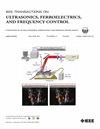Deep-Learning-Driven High Spatial Resolution Attenuation Imaging for Ultrasound Tomography (AI-UT)
IF 3.7
2区 工程技术
Q1 ACOUSTICS
IEEE transactions on ultrasonics, ferroelectrics, and frequency control
Pub Date : 2025-07-24
DOI:10.1109/TUFFC.2025.3592578
引用次数: 0
Abstract
Ultrasonic attenuation can be used to characterize tissue properties of the human breast. Both quantitative ultrasound (QUS) and ultrasound tomography (USCT) can provide attenuation estimation. However, limitations have been identified for both approaches. In QUS, the generation of attenuation maps involves separating the whole image into different data blocks. The optimal size of the data block is around 15–30 pulse lengths, which dramatically decreases the spatial resolution for attenuation imaging. In USCT, the attenuation is often estimated with a full wave inversion (FWI) method, which is affected by background noise. To achieve a high-resolution attenuation image with low variance, a deep learning (DL)-based method was proposed. In the approach, RF data from 60 angle views from the QTI Breast Acoustic CT (BACT) scanner were acquired as the input and attenuation images as the output. To improve image quality for the DL method, the spatial correlation between speed of sound (SOS) and attenuation were used as a constraint in the model. The results indicated that by including the SOS structural information, the performance of the model was improved. With a higher spatial resolution attenuation image, further segmentation of the breast can be achieved. The structural information and actual attenuation values provided by DL-generated attenuation images were validated with the values from the literature and the SOS-based segmentation map. The information provided by DL-generated attenuation images can be used as an additional biomarker for breast cancer diagnosis.深度学习驱动的高空间分辨率超声断层成像(AI-UT)。
超声衰减可以用来表征人体乳房的组织特性。定量超声(QUS)和超声断层扫描(USCT)都可以提供衰减估计。然而,这两种方法都有其局限性。在QUS中,衰减图的生成涉及到将整个图像分割成不同的数据块。数据块的最佳尺寸约为15至30个脉冲长度,这大大降低了衰减成像的空间分辨率。在USCT中,通常采用受背景噪声影响的全波反演(FWI)方法来估计衰减。为了获得低方差的高分辨率衰减图像,提出了一种基于深度学习的衰减图像提取方法。在该方法中,从QTI乳腺声学CTTM扫描仪获得60个角度的射频数据作为输入,衰减图像作为输出。为了提高DL方法的图像质量,在模型中使用声速(SOS)与衰减之间的空间相关性作为约束。结果表明,加入SOS结构信息后,模型的性能得到了改善。利用更高的空间分辨率衰减图像,可以实现对乳房的进一步分割。将dl生成的衰减图像提供的结构信息和实际衰减值与文献值和基于sos的分割图进行验证。dl生成的衰减图像提供的信息可以作为乳腺癌诊断的额外生物标志物。
本文章由计算机程序翻译,如有差异,请以英文原文为准。
求助全文
约1分钟内获得全文
求助全文
来源期刊
CiteScore
7.70
自引率
16.70%
发文量
583
审稿时长
4.5 months
期刊介绍:
IEEE Transactions on Ultrasonics, Ferroelectrics and Frequency Control includes the theory, technology, materials, and applications relating to: (1) the generation, transmission, and detection of ultrasonic waves and related phenomena; (2) medical ultrasound, including hyperthermia, bioeffects, tissue characterization and imaging; (3) ferroelectric, piezoelectric, and piezomagnetic materials, including crystals, polycrystalline solids, films, polymers, and composites; (4) frequency control, timing and time distribution, including crystal oscillators and other means of classical frequency control, and atomic, molecular and laser frequency control standards. Areas of interest range from fundamental studies to the design and/or applications of devices and systems.

 求助内容:
求助内容: 应助结果提醒方式:
应助结果提醒方式:


